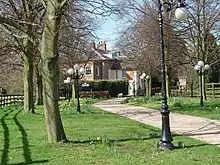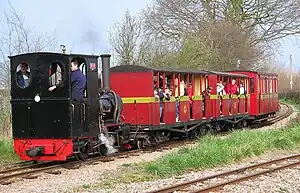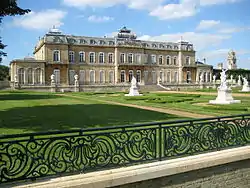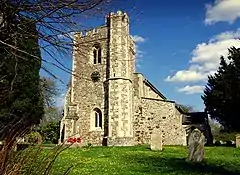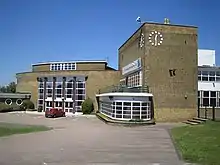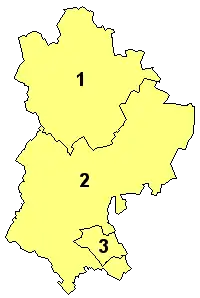
A civil parish is a country subdivision, forming the lowest unit of local government in England. There are 125 civil parishes in the ceremonial county of Bedfordshire, most of the county being parished: Luton is completely unparished; Central Bedfordshire is entirely parished. At the 2001 census, there were 312,301 people living in the 125 parishes, which accounted for 55.2 per cent of the county's population.
History
Parishes arose from Church of England divisions, and were originally purely ecclesiastical divisions. Over time they acquired civil administration powers.[1]
The Highways Act 1555 made parishes responsible for the upkeep of roads. Every adult inhabitant of the parish was obliged to work four days a year on the roads, providing their own tools, carts and horses; the work was overseen by an unpaid local appointee, the Surveyor of Highways.[2]
The poor were looked after by the monasteries, until their dissolution. In 1572, magistrates were given power to 'survey the poor' and impose taxes for their relief. This system was made more formal by the Poor Law Act 1601, which made parishes responsible for administering the Poor Law; overseers were appointed to charge a rate to support the poor of the parish.[3] The 19th century saw an increase in the responsibility of parishes, although the Poor Law powers were transferred to Poor Law Unions.[4] The Public Health Act 1872 grouped parishes into Rural Sanitary Districts, based on the Poor Law Unions; these subsequently formed the basis for Rural Districts.[5]
Parishes were run by vestries, meeting annually to appoint officials, and were generally identical to ecclesiastical parishes,[6] although some townships in large parishes administered the Poor Law themselves; under the Divided Parishes and Poor Law Amendment Act 1882, all extra-parochial areas and townships that levied a separate rate became independent civil parishes.[7]
Civil parishes in their modern sense date from the Local Government Act 1894, which abolished vestries; established elected parish councils in all rural parishes with more than 300 electors; grouped rural parishes into Rural Districts; and aligned parish boundaries with county and borough boundaries.[7] Urban civil parishes continued to exist, and were generally coterminous with the Urban District, Municipal Borough or County Borough in which they were situated; many large towns contained a number of parishes, and these were usually merged into one. Parish councils were not formed in urban areas, and the only function of the parish was to elect guardians to Poor Law Unions; with the abolition of the Poor Law system in 1930 the parishes had only a nominal existence.[8]
The Local Government Act 1972 retained civil parishes in rural areas, and many former Urban Districts and Municipal Boroughs that were being abolished, were replaced by new successor parishes; urban areas that were considered too large to be single parishes became unparished areas.[9]
The current position
Recent governments have encouraged the formation of town and parish councils in unparished areas, and the Local Government and Rating Act 1997 gave local residents the right to demand the creation of a new civil parish.[10]
A parish council can become a town council unilaterally, simply by resolution;[9] and a civil parish can also gain city status, but only if that is granted by the Crown.[9] The chairman of a town or city council is called a mayor.[9] The Local Government and Public Involvement in Health Act 2007 introduced alternative names: a parish council can now choose to be called a community; village; or neighbourhood council.[11]
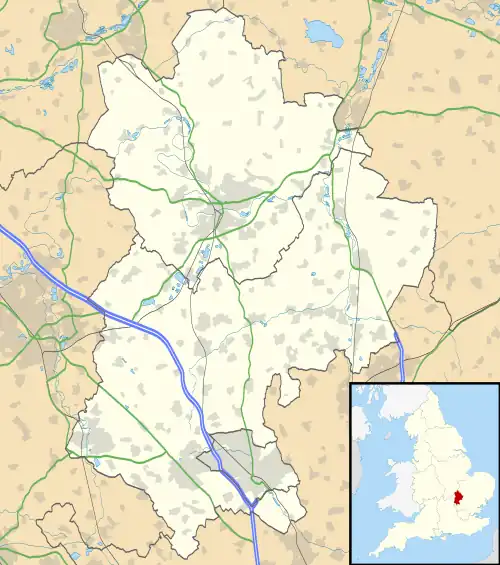
List of civil parishes and unparished areas
See also
References
- ↑ Angus Winchester, 2000, Discovering Parish Boundaries. Shire Publications. Princes Risborough, 96 pages ISBN 978-0-7478-0470-3
- ↑ RAC Foundation : What Went Wrong? British Highway Development Before Motorways Retrieved 22 August 2009
- ↑ The Victorian Web : The Poor Law : Introduction Retrieved 22 August 2009
- ↑ Staffordshire University : Poor Law Unions and Registration Districts Archived 14 September 2012 at archive.today Retrieved 22 August 2009
- ↑ A Vision of Britain Through Time : Status Details for Rural Sanitary District Retrieved 22 August 2009
- ↑ Robert Tittler, The Reformation and the Towns in England, 1998, Oxford University Press, 395 pages, ISBN 978-0-19-820718-4
- 1 2 Modern British Surnames : Selected Events in the History of Civil Registration and Boundary Changes 1801-1996 Archived 1 August 2010 at the Wayback Machine Retrieved 22 August 2009
- ↑ Alex MacMorran and T R Colquhoun Dill, The Local Government Act 1894 and the Subsequent Statutes Affecting Parish Councils, 1907, Butterworth and Co, London, 626 pages
- 1 2 3 4 Office of Public Sector Information : Local Government Act 1972 Archived 5 December 2012 at archive.today Retrieved 22 August 2009
- ↑ Office of Public Sector Information : Local Government and Rating Act 1997 Archived 5 August 2012 at archive.today Retrieved 22 August 2009
- ↑ Office of Public Sector Information : Local Government and Public Involvement in Health Act 2007 Archived 5 August 2012 at archive.today Retrieved 22 August 2009
- ↑ From 1974 to 2009, Central Bedfordshire was divided into districts: Mid Bedfordshire, formed from Ampthill Rural District, Ampthill Urban District, Biggleswade Rural District, Biggleswade Urban District and Sandy Urban District; and South Bedfordshire, formed from Dunstable Municipal Borough, Leighton–Linslade Urban District and Luton Rural District.
- 1 2 A Vision of Britain Through Time : Bedford Municipal Borough Retrieved 15 October 2010
- ↑ Office for National Statistics : Census 2001 : Table KS01 : Usual Resident Population Archived 22 April 2015 at the Wayback Machine Castle; Cauldwell (part); De Parys; Goldington (part); Harpur; Kempston East (part); Kempston North (part); Kingsbrook (part); Newnham; Putnoe; Queen's Park; and Wilshamstead (part) wards. Retrieved 15 October 2010
- 1 2 3 4 5 6 7 8 9 10 11 12 13 14 15 16 17 18 19 20 21 22 23 24 25 26 27 28 29 30 31 32 33 34 35 36 37 38 39 40 41 42 43 44 45 46 A Vision of Britain Through Time : Bedford Rural District Archived 14 May 2011 at the Wayback Machine Retrieved 15 October 2010
- ↑ Office for National Statistics : Census 2001 : Table KS01 : Usual Resident Population Archived 22 April 2015 at the Wayback Machine Bromham (part) ward. Retrieved 15 October 2010
- 1 2 3 4 5 6 7 8 9 10 11 12 13 14 15 16 17 18 19 20 21 22 23 24 25 26 27 28 29 30 31 32 33 34 35 36 37 38 39 40 41 42 43 Office for National Statistics : Census 2001 : Parish Headcounts : Bedford Archived 12 June 2011 at the Wayback Machine Retrieved 15 October 2010
- ↑ Office for National Statistics : Census 2001 : Table KS01 : Usual Resident Population Archived 22 April 2015 at the Wayback Machine Brickhill ward. Retrieved 15 October 2010
- ↑ The Bedford (Parish) Order 2004 Archived 19 May 2011 at the Wayback Machine Retrieved 15 October 2010
- ↑ Office for National Statistics : Census 2001 : Table KS01 : Usual Resident Population Archived 22 April 2015 at the Wayback Machine Bromham (part); and Turvey (part) wards. Retrieved 15 October 2010
- 1 2 3 The Bedford (Parishes Electoral Arrangements) Order 2007 Retrieved 15 October 2010
- ↑ A Vision of Britain Through Time : Kempston Urban District Retrieved 15 October 2010
- 1 2 Office for National Statistics : Census 2001 : Table KS01 : Usual Resident Population Archived 22 April 2015 at the Wayback Machine Roxton (part) ward. Retrieved 15 October 2010
- ↑ "Wilstead-Wixams". Archived from the original on 23 September 2015. Retrieved 12 April 2015.
- ↑ A Vision of Britain Through Time : Ampthill Urban District Retrieved 15 October 2010
- 1 2 3 4 5 6 7 8 9 10 11 12 13 14 15 16 17 18 19 20 21 22 23 24 25 26 27 28 29 30 31 32 33 34 35 36 37 38 39 40 41 42 43 44 45 46 47 48 49 50 51 52 53 54 55 Office for National Statistics : Census 2001 : Parish Headcounts : Mid Bedfordshire Archived 26 May 2013 at the Wayback Machine Retrieved 15 October 2010
- 1 2 3 4 5 6 7 8 9 10 11 12 13 14 15 16 17 18 19 20 21 22 23 A Vision of Britain Through Time : Biggleswade Rural District Retrieved 15 October 2010
- 1 2 3 4 5 6 7 8 9 10 11 12 13 14 15 16 17 18 19 20 21 22 23 24 25 26 27 28 29 A Vision of Britain Through Time : Ampthill Rural District Archived 14 May 2011 at the Wayback Machine Retrieved 15 October 2010
- 1 2 3 4 5 6 7 8 9 10 11 12 13 14 15 16 17 18 19 20 21 A Vision of Britain Through Time : Luton Rural District Archived 1 October 2007 at the Wayback Machine Retrieved 15 October 2010
- 1 2 3 4 5 6 7 8 9 10 11 12 13 14 15 16 17 18 19 20 21 22 23 Office for National Statistics : Census 2001 : Parish Headcounts : South Bedfordshire Archived 12 June 2011 at the Wayback Machine Retrieved 15 October 2010
- ↑ A Vision of Britain Through Time : Biggleswade Urban District Retrieved 15 October 2010
- ↑ "Billington". Mapit. Retrieved 16 July 2019.
- ↑ A Vision of Britain Through Time : Dunstable Municipal Borough Retrieved 15 October 2010
- ↑ "Historic moment for community's parish council - Biggleswade Today". Archived from the original on 23 September 2015. Retrieved 26 May 2013.
- ↑ A Vision of Britain Through Time : Leighton–Linslade Urban District Retrieved 15 October 2010
- ↑ A Vision of Britain Through Time : Sandy Urban District Retrieved 15 October 2010
- ↑ A Vision of Britain Through Time : Luton County Borough Retrieved 15 October 2010
- ↑ Office for National Statistics : Census 2001 : Table KS01 : Usual Resident Population Archived 22 April 2015 at the Wayback Machine Barnfield; Biscot; Bramingham; Challney; Crawley; Dallow; Farley; High Town; Icknield; Leagrave; Lewsey; Limbury; Northwell; Round Green; Saints; South; Stopsley; Sundon Park; and Wigmore wards. Retrieved 15 October 2010







_-_geograph.org.uk_-_22566.jpg.webp)



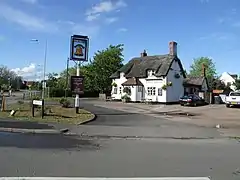







_-_geograph.org.uk_-_363338.jpg.webp)















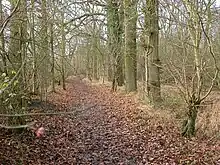

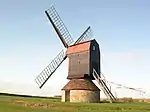







_-_geograph.org.uk_-_563921.jpg.webp)


















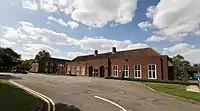
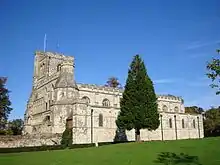








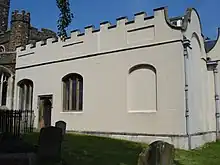


Mar2005.jpg.webp)






